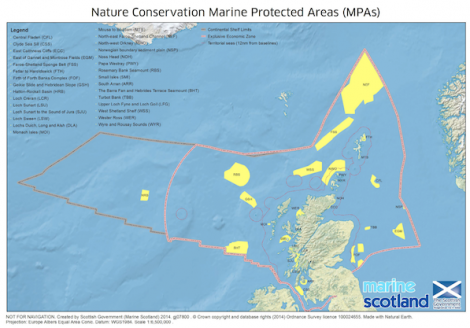News / Marine areas designated, protection unknown
FOUR sea zones off Shetland are amongst 30 marine protected areas announced by the Scottish government on Thursday, though the level of protection afforded these areas has yet to be negotiated.
An area stretching from the isle of Mousa to Boddam off Shetland’s sout east coast has been designated to protect sandeels, a major source of food of seabirds.
A larger zone covering the waters around the islands of Fetlar and Unst are considered an important area for black guillemots.
The government is also protecting two vast swathes of ocean north and west of Shetland, including 23,682 square kilometres around the north east Faroe-Shetland Channel, and 5,278 kilometres on the Faroe-Shetland Sponge Belt.
Shetland MSP Tavish Scott was swift to criticise the move, saying it would have unknown consequences for the fishing and energy industries and that economic interests should have been given advance warning of the announcement.
Meanwhile Fair Isle, which has been campaigning for a marine protected area for the past 25 years, has been left out.
Scottish environment minister Richard Lochhead insisted the new sites would help protect and enhance the marine environment as “a prized asset for future generations”.
“Our waters support a huge diversity of marine life and habitats, with around 6,500 species of plants and animals and are among the richest in Europe for marine mammals,” he said.
“Many of these sites will provide protections for our seabirds like the black guillemot and sandeels which provide a vital food source. It is our duty to protect these species and habitats for the present as well as the future.”
However RSPB Scotland’s marine policy officer Allan Whyte said detailed discussions about how these designated areas would be managed had yet to take place.
“In terms of what can and cannot happen in a marine protected area we can’t say for sure yet,” he said.
Become a member of Shetland News
“From our point of view we want the best for the marine environment, but these particular areas are not just for species and habitats, they are for the communities as well. We want to see an outcome that suits everybody.”
Meanwhile Tavish Scott said that the government would need to address industry concerns “sooner rather than later”.
He said: “There are a number of key issues which will cause concern, such as the designation of vast fishing areas with new, unknown management regimes and the potential consequential effects to the oil and gas industry west of Shetland.”
Nick Riddiford, of the Fair Isle Marine Environment and Tourism Initiative, said the small island and its surrounding waters were still being considered by the Scottish government as an MPA.
He said he was still hopeful that Fair Isle could be designated as a “demonstration project” sometime in the future.
In other reaction, Scottish Environment Link said that the government had started to recognise the importance of protecting sealife and marine habitats that had suffered many years of unchecked decline.
The announcement was praised by Alistair Sinclair of the Scottish Creel Fishermen’s Federation saying they could create more opportunities for coastal communities.
WWF Scotland director Lang Banks this was a step towards economic interests operating without undermining the health of the seas.
The National Trust, which owns Fair Isle, said they hoped these new MPAs marked “a new regionally-sensitive approach to coastal and marine management”.
Become a member of Shetland News
Shetland News is asking its readers to consider paying for membership to get additional perks:
- Removal of third-party ads;
- Bookmark posts to read later;
- Exclusive curated weekly newsletter;
- Hide membership messages;
- Comments open for discussion.
If you appreciate what we do and feel strongly about impartial local journalism, then please become a member of Shetland News by either making a single payment, or setting up a monthly, quarterly or yearly subscription.





























































